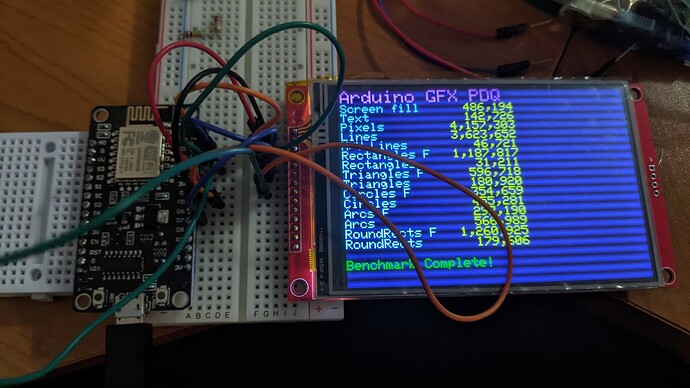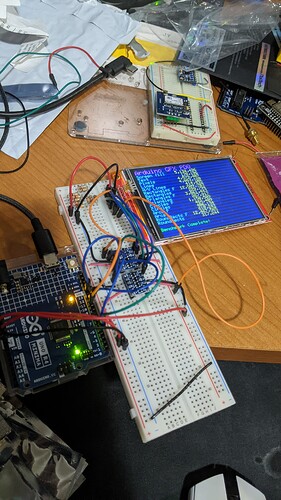@ZinggJM instead of rushing with the jumper method, I decided to test with a nodemcu esp8266 I had lying around. Following this guide, I was able to get it working!
I then tested PDQgraphicstest but for some reason I only got a blank/white screen, so I decided to condense everything into one file here.
/*******************************************************************************
* Modified from PDQgraphicstest example of Arduino_GFX
* run on Nodemcu esp8266 + 480x320 ILI9488 SPI TFT
******************************************************************************/
#include <Arduino_GFX_Library.h>
#define TFT_CS 16 //GPIO16 - D0
#define TFT_RESET 5 //GPIO5 - D1
#define TFT_DC 4 //GPIO4 - D2
#define TFT_MOSI 13 //GPIO13/MOSI - D7
#define TFT_SCK 14 //GPIO14/SCK - D5
#define TFT_LED 0 //GPIO0 - D3
#define TFT_MISO -1 // not used for TFT
#define GFX_BL TFT_LED // backlight pin
/* More data bus class: https://github.com/moononournation/Arduino_GFX/wiki/Data-Bus-Class */
Arduino_DataBus *bus = new Arduino_HWSPI(TFT_DC, TFT_CS);
/* More display class: https://github.com/moononournation/Arduino_GFX/wiki/Display-Class */
Arduino_GFX *gfx = new Arduino_ILI9488_18bit(bus, TFT_RESET, 3 /* rotation */, false /* IPS */);
/*******************************************************************************
* End of Arduino_GFX setting
******************************************************************************/
int32_t w, h, n, n1, cx, cy, cx1, cy1, cn, cn1;
uint8_t tsa, tsb, tsc, ds;
void setup() {
Serial.begin(115200);
// Serial.setDebugOutput(true);
// while(!Serial);
Serial.println("Arduino_GFX PDQgraphicstest example!");
#ifdef GFX_EXTRA_PRE_INIT
GFX_EXTRA_PRE_INIT();
#endif
// Init Display
if (!gfx->begin())
// if (!gfx->begin(80000000)) /* specify data bus speed */
{
Serial.println("gfx->begin() failed!");
}
w = gfx->width();
h = gfx->height();
n = min(w, h);
n1 = n - 1;
cx = w / 2;
cy = h / 2;
cx1 = cx - 1;
cy1 = cy - 1;
cn = min(cx1, cy1);
cn1 = cn - 1;
tsa = ((w <= 176) || (h <= 160)) ? 1 : (((w <= 240) || (h <= 240)) ? 2 : 3); // text size A
tsb = ((w <= 272) || (h <= 220)) ? 1 : 2; // text size B
tsc = ((w <= 220) || (h <= 220)) ? 1 : 2; // text size C
ds = (w <= 160) ? 9 : 12; // digit size
#ifdef GFX_BL
pinMode(GFX_BL, OUTPUT);
digitalWrite(GFX_BL, HIGH);
#endif
}
static inline uint32_t micros_start() __attribute__((always_inline));
static inline uint32_t micros_start() {
uint8_t oms = millis();
while ((uint8_t)millis() == oms)
;
return micros();
}
void loop(void) {
Serial.println(F("Benchmark\tmicro-secs"));
int32_t usecFillScreen = testFillScreen();
serialOut(F("Screen fill\t"), usecFillScreen, 100, true);
int32_t usecText = testText();
serialOut(F("Text\t"), usecText, 3000, true);
int32_t usecPixels = testPixels();
serialOut(F("Pixels\t"), usecPixels, 100, true);
int32_t usecLines = testLines();
serialOut(F("Lines\t"), usecLines, 100, true);
int32_t usecFastLines = testFastLines();
serialOut(F("Horiz/Vert Lines\t"), usecFastLines, 100, true);
int32_t usecFilledRects = testFilledRects();
serialOut(F("Rectangles (filled)\t"), usecFilledRects, 100, false);
int32_t usecRects = testRects();
serialOut(F("Rectangles (outline)\t"), usecRects, 100, true);
int32_t usecFilledTrangles = testFilledTriangles();
serialOut(F("Triangles (filled)\t"), usecFilledTrangles, 100, false);
int32_t usecTriangles = testTriangles();
serialOut(F("Triangles (outline)\t"), usecTriangles, 100, true);
int32_t usecFilledCircles = testFilledCircles(10);
serialOut(F("Circles (filled)\t"), usecFilledCircles, 100, false);
int32_t usecCircles = testCircles(10);
serialOut(F("Circles (outline)\t"), usecCircles, 100, true);
int32_t usecFilledArcs = testFillArcs();
serialOut(F("Arcs (filled)\t"), usecFilledArcs, 100, false);
int32_t usecArcs = testArcs();
serialOut(F("Arcs (outline)\t"), usecArcs, 100, true);
int32_t usecFilledRoundRects = testFilledRoundRects();
serialOut(F("Rounded rects (filled)\t"), usecFilledRoundRects, 100, false);
int32_t usecRoundRects = testRoundRects();
serialOut(F("Rounded rects (outline)\t"), usecRoundRects, 100, true);
#ifdef CANVAS
uint32_t start = micros_start();
gfx->flush();
int32_t usecFlush = micros() - start;
serialOut(F("flush (Canvas only)\t"), usecFlush, 0, false);
#endif
Serial.println(F("Done!"));
uint16_t c = 4;
int8_t d = 1;
for (int32_t i = 0; i < h; i++) {
gfx->drawFastHLine(0, i, w, c);
c += d;
if (c <= 4 || c >= 11) {
d = -d;
}
}
gfx->setCursor(0, 0);
gfx->setTextSize(tsa);
gfx->setTextColor(MAGENTA);
gfx->println(F("Arduino GFX PDQ"));
if (h > w) {
gfx->setTextSize(tsb);
gfx->setTextColor(GREEN);
gfx->print(F("\nBenchmark "));
gfx->setTextSize(tsc);
if (ds == 12) {
gfx->print(F(" "));
}
gfx->println(F("micro-secs"));
}
printnice(F("Screen fill "), usecFillScreen);
printnice(F("Text "), usecText);
printnice(F("Pixels "), usecPixels);
printnice(F("Lines "), usecLines);
printnice(F("H/V Lines "), usecFastLines);
printnice(F("Rectangles F"), usecFilledRects);
printnice(F("Rectangles "), usecRects);
printnice(F("Triangles F "), usecFilledTrangles);
printnice(F("Triangles "), usecTriangles);
printnice(F("Circles F "), usecFilledCircles);
printnice(F("Circles "), usecCircles);
printnice(F("Arcs F "), usecFilledArcs);
printnice(F("Arcs "), usecArcs);
printnice(F("RoundRects F"), usecFilledRoundRects);
printnice(F("RoundRects "), usecRoundRects);
if ((h > w) || (h > 240)) {
gfx->setTextSize(tsc);
gfx->setTextColor(GREEN);
gfx->print(F("\nBenchmark Complete!"));
}
#ifdef CANVAS
gfx->flush();
#endif
delay(60 * 1000L);
}
#ifdef ESP32
void serialOut(const char *item, int32_t v, uint32_t d, bool clear)
#else
void serialOut(const __FlashStringHelper *item, int32_t v, uint32_t d, bool clear)
#endif
{
#ifdef CANVAS
gfx->flush();
#endif
Serial.print(item);
if (v < 0) {
Serial.println(F("N/A"));
} else {
Serial.println(v);
}
delay(d);
if (clear) {
gfx->fillScreen(BLACK);
}
}
#ifdef ESP32
void printnice(const char *item, long int v)
#else
void printnice(const __FlashStringHelper *item, long int v)
#endif
{
gfx->setTextSize(tsb);
gfx->setTextColor(CYAN);
gfx->print(item);
gfx->setTextSize(tsc);
gfx->setTextColor(YELLOW);
if (v < 0) {
gfx->println(F(" N / A"));
} else {
char str[32] = { 0 };
#ifdef RTL8722DM
sprintf(str, "%d", (int)v);
#else
sprintf(str, "%ld", v);
#endif
for (char *p = (str + strlen(str)) - 3; p > str; p -= 3) {
memmove(p + 1, p, strlen(p) + 1);
*p = ',';
}
while (strlen(str) < ds) {
memmove(str + 1, str, strlen(str) + 1);
*str = ' ';
}
gfx->println(str);
}
}
int32_t testFillScreen() {
uint32_t start = micros_start();
// Shortened this tedious test!
gfx->fillScreen(WHITE);
gfx->fillScreen(RED);
gfx->fillScreen(GREEN);
gfx->fillScreen(BLUE);
gfx->fillScreen(BLACK);
return micros() - start;
}
int32_t testText() {
uint32_t start = micros_start();
gfx->setCursor(0, 0);
gfx->setTextSize(1);
gfx->setTextColor(WHITE, BLACK);
gfx->println(F("Hello World!"));
gfx->setTextSize(2);
gfx->setTextColor(gfx->color565(0xff, 0x00, 0x00));
gfx->print(F("RED "));
gfx->setTextColor(gfx->color565(0x00, 0xff, 0x00));
gfx->print(F("GREEN "));
gfx->setTextColor(gfx->color565(0x00, 0x00, 0xff));
gfx->println(F("BLUE"));
gfx->setTextSize(tsa);
gfx->setTextColor(YELLOW);
gfx->println(1234.56);
gfx->setTextColor(WHITE);
gfx->println((w > 128) ? 0xDEADBEEF : 0xDEADBEE, HEX);
gfx->setTextColor(CYAN, WHITE);
gfx->println(F("Groop,"));
gfx->setTextSize(tsc);
gfx->setTextColor(MAGENTA, WHITE);
gfx->println(F("I implore thee,"));
gfx->setTextSize(1);
gfx->setTextColor(NAVY, WHITE);
gfx->println(F("my foonting turlingdromes."));
gfx->setTextColor(DARKGREEN, WHITE);
gfx->println(F("And hooptiously drangle me"));
gfx->setTextColor(DARKCYAN, WHITE);
gfx->println(F("with crinkly bindlewurdles,"));
gfx->setTextColor(MAROON, WHITE);
gfx->println(F("Or I will rend thee"));
gfx->setTextColor(PURPLE, WHITE);
gfx->println(F("in the gobberwartsb"));
gfx->setTextColor(OLIVE, WHITE);
gfx->println(F("with my blurglecruncheon,"));
gfx->setTextColor(DARKGREY, WHITE);
gfx->println(F("see if I don't!"));
gfx->setTextSize(2);
gfx->setTextColor(RED);
gfx->println(F("Size 2"));
gfx->setTextSize(3);
gfx->setTextColor(ORANGE);
gfx->println(F("Size 3"));
gfx->setTextSize(4);
gfx->setTextColor(YELLOW);
gfx->println(F("Size 4"));
gfx->setTextSize(5);
gfx->setTextColor(GREENYELLOW);
gfx->println(F("Size 5"));
gfx->setTextSize(6);
gfx->setTextColor(GREEN);
gfx->println(F("Size 6"));
gfx->setTextSize(7);
gfx->setTextColor(BLUE);
gfx->println(F("Size 7"));
gfx->setTextSize(8);
gfx->setTextColor(PURPLE);
gfx->println(F("Size 8"));
gfx->setTextSize(9);
gfx->setTextColor(PINK);
gfx->println(F("Size 9"));
return micros() - start;
}
int32_t testPixels() {
uint32_t start = micros_start();
for (int16_t y = 0; y < h; y++) {
for (int16_t x = 0; x < w; x++) {
gfx->drawPixel(x, y, gfx->color565(x << 3, y << 3, x * y));
}
#ifdef ESP8266
yield(); // avoid long run triggered ESP8266 WDT restart
#endif
}
return micros() - start;
}
int32_t testLines() {
uint32_t start;
int32_t x1, y1, x2, y2;
start = micros_start();
x1 = y1 = 0;
y2 = h - 1;
for (x2 = 0; x2 < w; x2 += 6) {
gfx->drawLine(x1, y1, x2, y2, BLUE);
}
#ifdef ESP8266
yield(); // avoid long run triggered ESP8266 WDT restart
#endif
x2 = w - 1;
for (y2 = 0; y2 < h; y2 += 6) {
gfx->drawLine(x1, y1, x2, y2, BLUE);
}
#ifdef ESP8266
yield(); // avoid long run triggered ESP8266 WDT restart
#endif
x1 = w - 1;
y1 = 0;
y2 = h - 1;
for (x2 = 0; x2 < w; x2 += 6) {
gfx->drawLine(x1, y1, x2, y2, BLUE);
}
#ifdef ESP8266
yield(); // avoid long run triggered ESP8266 WDT restart
#endif
x2 = 0;
for (y2 = 0; y2 < h; y2 += 6) {
gfx->drawLine(x1, y1, x2, y2, BLUE);
}
#ifdef ESP8266
yield(); // avoid long run triggered ESP8266 WDT restart
#endif
x1 = 0;
y1 = h - 1;
y2 = 0;
for (x2 = 0; x2 < w; x2 += 6) {
gfx->drawLine(x1, y1, x2, y2, BLUE);
}
#ifdef ESP8266
yield(); // avoid long run triggered ESP8266 WDT restart
#endif
x2 = w - 1;
for (y2 = 0; y2 < h; y2 += 6) {
gfx->drawLine(x1, y1, x2, y2, BLUE);
}
#ifdef ESP8266
yield(); // avoid long run triggered ESP8266 WDT restart
#endif
x1 = w - 1;
y1 = h - 1;
y2 = 0;
for (x2 = 0; x2 < w; x2 += 6) {
gfx->drawLine(x1, y1, x2, y2, BLUE);
}
#ifdef ESP8266
yield(); // avoid long run triggered ESP8266 WDT restart
#endif
x2 = 0;
for (y2 = 0; y2 < h; y2 += 6) {
gfx->drawLine(x1, y1, x2, y2, BLUE);
}
#ifdef ESP8266
yield(); // avoid long run triggered ESP8266 WDT restart
#endif
return micros() - start;
}
int32_t testFastLines() {
uint32_t start;
int32_t x, y;
start = micros_start();
for (y = 0; y < h; y += 5) {
gfx->drawFastHLine(0, y, w, RED);
}
for (x = 0; x < w; x += 5) {
gfx->drawFastVLine(x, 0, h, BLUE);
}
return micros() - start;
}
int32_t testFilledRects() {
uint32_t start;
int32_t i, i2;
start = micros_start();
for (i = n; i > 0; i -= 6) {
i2 = i / 2;
gfx->fillRect(cx - i2, cy - i2, i, i, gfx->color565(i, i, 0));
}
return micros() - start;
}
int32_t testRects() {
uint32_t start;
int32_t i, i2;
start = micros_start();
for (i = 2; i < n; i += 6) {
i2 = i / 2;
gfx->drawRect(cx - i2, cy - i2, i, i, GREEN);
}
return micros() - start;
}
int32_t testFilledCircles(uint8_t radius) {
uint32_t start;
int32_t x, y, r2 = radius * 2;
start = micros_start();
for (x = radius; x < w; x += r2) {
for (y = radius; y < h; y += r2) {
gfx->fillCircle(x, y, radius, MAGENTA);
}
}
return micros() - start;
}
int32_t testCircles(uint8_t radius) {
uint32_t start;
int32_t x, y, r2 = radius * 2;
int32_t w1 = w + radius;
int32_t h1 = h + radius;
// Screen is not cleared for this one -- this is
// intentional and does not affect the reported time.
start = micros_start();
for (x = 0; x < w1; x += r2) {
for (y = 0; y < h1; y += r2) {
gfx->drawCircle(x, y, radius, WHITE);
}
}
return micros() - start;
}
int32_t testFillArcs() {
int16_t i, r = 360 / cn;
uint32_t start = micros_start();
for (i = 6; i < cn; i += 6) {
gfx->fillArc(cx1, cy1, i, i - 3, 0, i * r, RED);
}
return micros() - start;
}
int32_t testArcs() {
int16_t i, r = 360 / cn;
uint32_t start = micros_start();
for (i = 6; i < cn; i += 6) {
gfx->drawArc(cx1, cy1, i, i - 3, 0, i * r, WHITE);
}
return micros() - start;
}
int32_t testFilledTriangles() {
uint32_t start;
int32_t i;
start = micros_start();
for (i = cn1; i > 10; i -= 5) {
gfx->fillTriangle(cx1, cy1 - i, cx1 - i, cy1 + i, cx1 + i, cy1 + i,
gfx->color565(0, i, i));
}
return micros() - start;
}
int32_t testTriangles() {
uint32_t start;
int32_t i;
start = micros_start();
for (i = 0; i < cn; i += 5) {
gfx->drawTriangle(
cx1, cy1 - i, // peak
cx1 - i, cy1 + i, // bottom left
cx1 + i, cy1 + i, // bottom right
gfx->color565(0, 0, i));
}
return micros() - start;
}
int32_t testFilledRoundRects() {
uint32_t start;
int32_t i, i2;
start = micros_start();
for (i = n1; i > 20; i -= 6) {
i2 = i / 2;
gfx->fillRoundRect(cx - i2, cy - i2, i, i, i / 8, gfx->color565(0, i, 0));
}
return micros() - start;
}
int32_t testRoundRects() {
uint32_t start;
int32_t i, i2;
start = micros_start();
for (i = 20; i < n1; i += 6) {
i2 = i / 2;
gfx->drawRoundRect(cx - i2, cy - i2, i, i, i / 8, gfx->color565(i, 0, 0));
}
return micros() - start;
}
/***************************************************
Original sketch text:
This is an example sketch for the Adafruit 2.2" SPI display.
This library works with the Adafruit 2.2" TFT Breakout w/SD card
----> http://www.adafruit.com/products/1480
Check out the links above for our tutorials and wiring diagrams
These displays use SPI to communicate, 4 or 5 pins are required to
interface (RST is optional)
Adafruit invests time and resources providing this open source code,
please support Adafruit and open-source hardware by purchasing
products from Adafruit!
Written by Limor Fried/Ladyada for Adafruit Industries.
MIT license, all text above must be included in any redistribution
****************************************************/
So I'm now going to order some of those level converters for the R4, hopefully I can update you in the next couple of days. Thanks!






